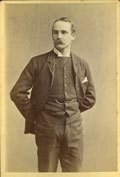Lewis Evans
 Lewis Evans |
Lewis Evans was the second son of John Evans and his first wife Harriet He was born in 1853 and attended Callipers, a prep-school in Chipperfield, Hertfordshire - the same school his brother Arthur had attended. He then went to a school in Sidmouth before going on to Harrow, but failed to excel at any of his schools and refused at first to go to University. 'Lewis could not spell, but liked blowing himself up with chemicals..... He was a gentle, lovable creature, with a shrewd wit but with a capacity for being led into trouble by Norman' (Time and Chance). John Evans apprenticed Lewis, who was just sixteen, to his wife's brother-in-law Fred Pratt Barlow, at a branch of John Dickinson & Co. in London, but this was a formality and in 1873 Lewis began to attend chemistry lectures at University College, London. He then went into the mills for four years, before taking off for America with his cousin to see the new world and the American paper industry. |
||||
On coming back from America, Lewis settled down into the mills; he became a partner in Dickinson's in 1881; he was made a director in 1885 after John Evans turned Dickinsons into a private limited company. Lewis played a major part in the reorganisation and modernisation of the mills. He introduced fire pumps and the first fire brigade in 1883, acting himself as captain of the brigade. The old water-driven machines in the mills were replaced by water turbines at his initiative, and he also introduced a rail link to the mill at Croxley in 1898. His first wife Beryl Ward was the daughter of the vicar at Apsley; she died aged 20 in 1886. In 1889 he married Eva Bradford, an officer's daughter. Lewis and Eva had five children.
|
|||||
Further References / Links:Joan Evans, Time and Chance: The Story of Arthur Evans and His Forebears (1943) |
|||||

